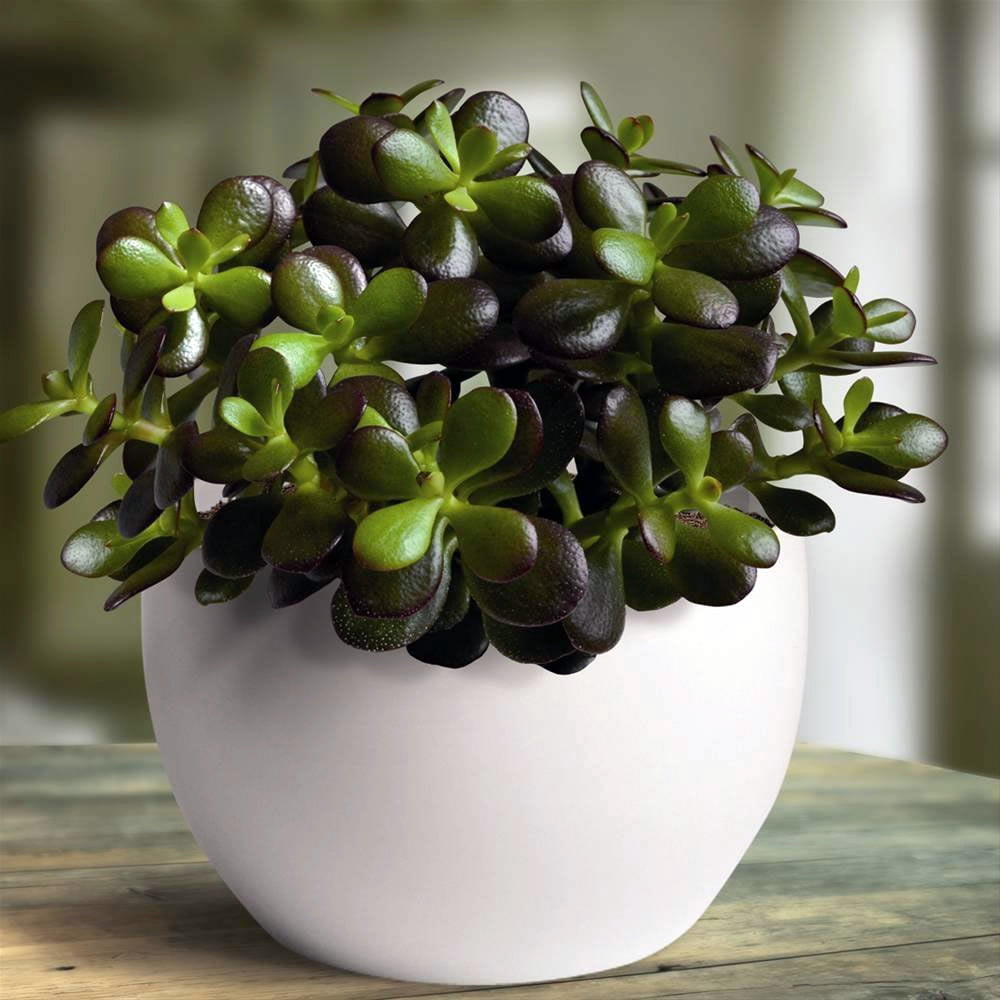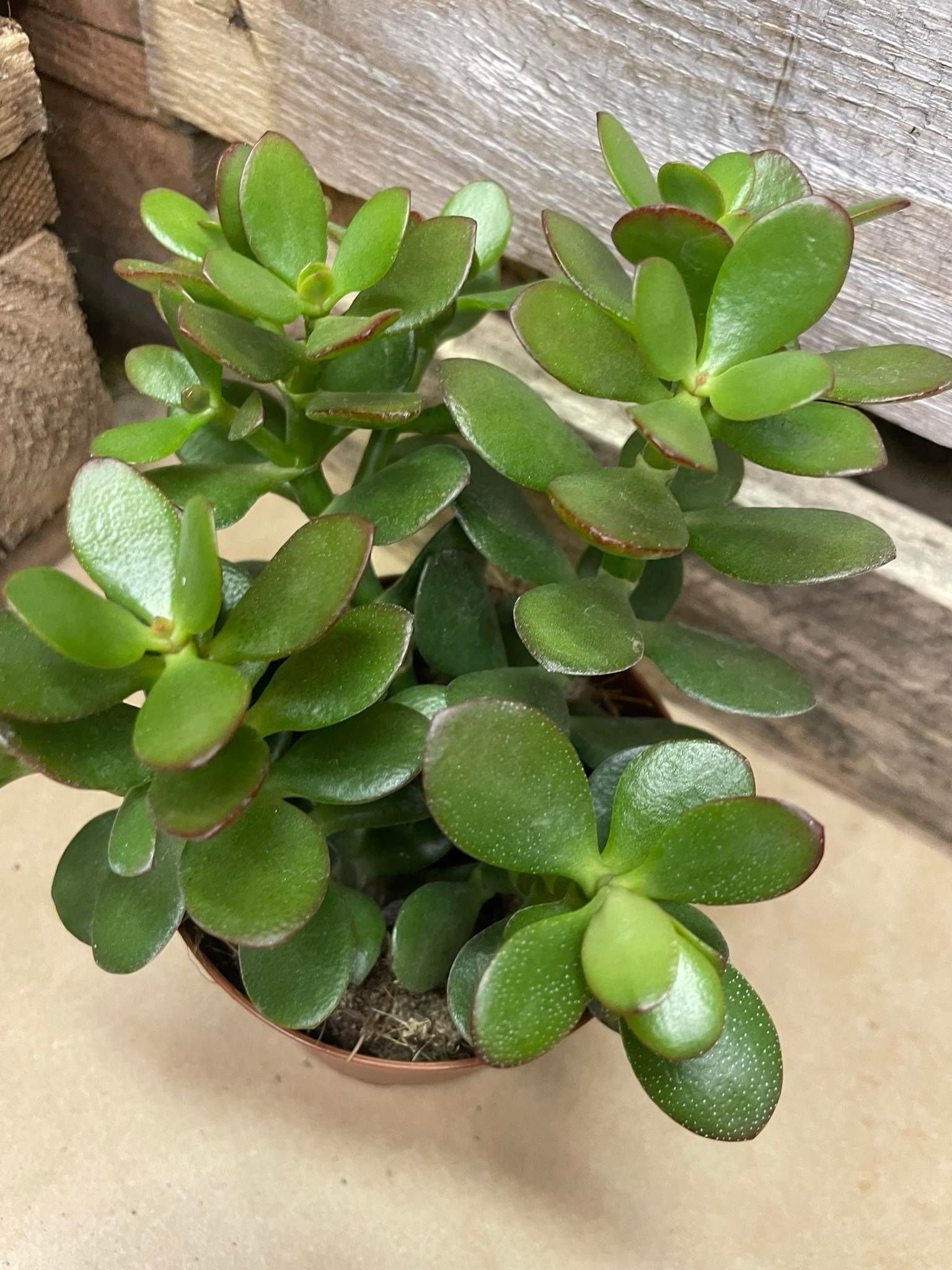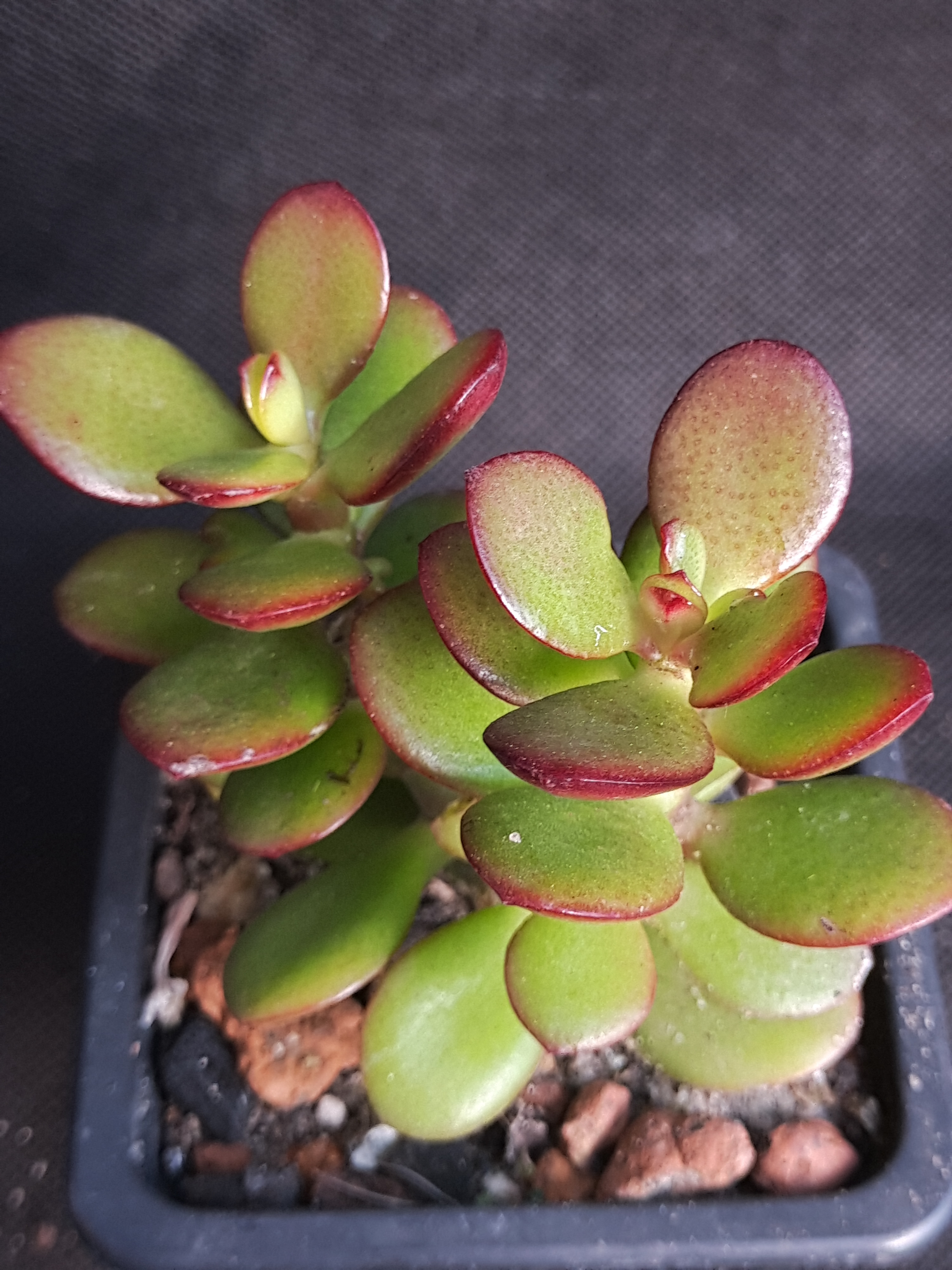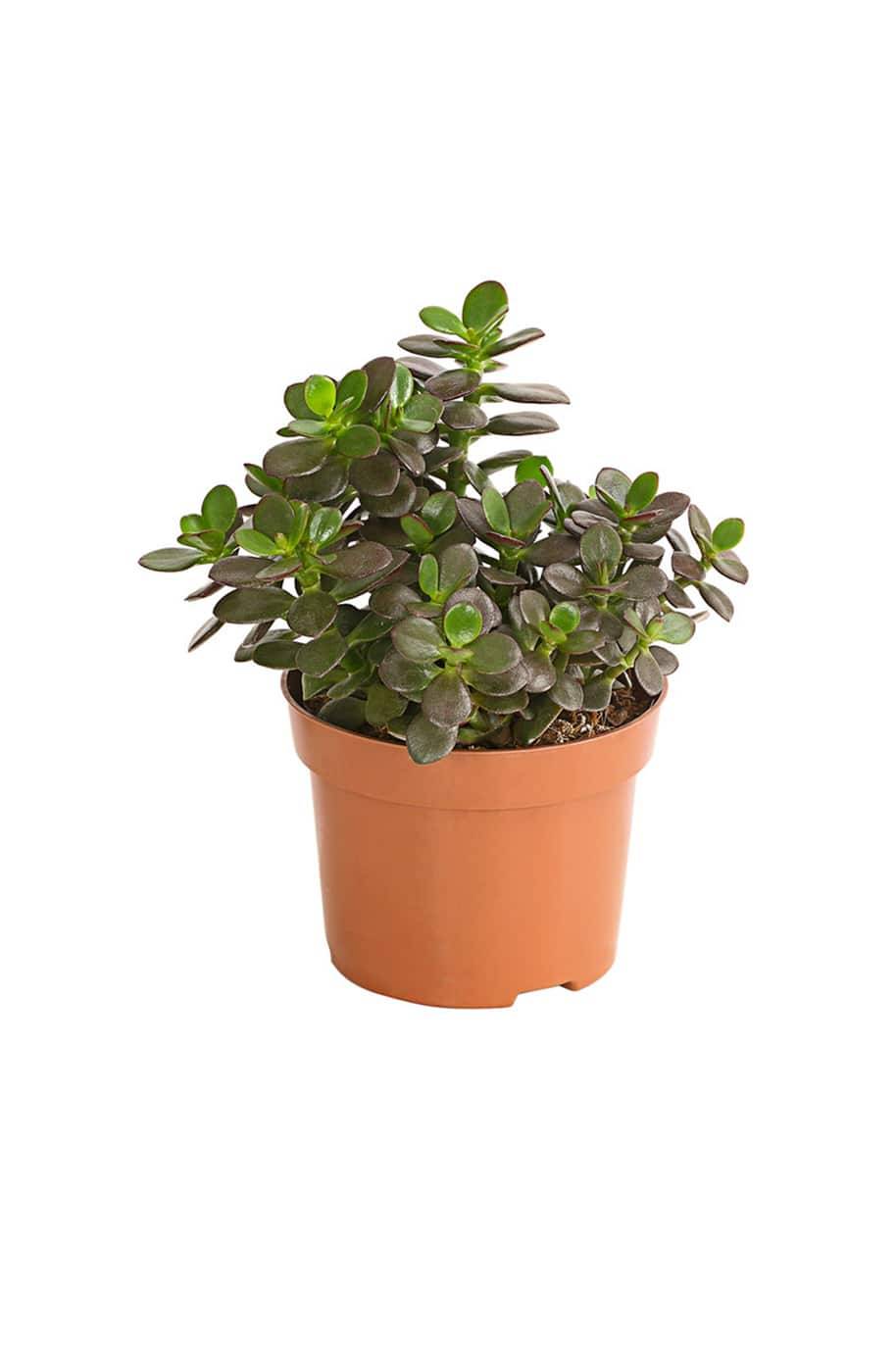
Dwarf Jade Plant Crassula ovata minor Easy to grow Succulent 2.5" Pot
Crassula ovata is a compact, well-branched, and rounded succulent with oval-shaped leaves that have a dark greyish-green color. The stem of Crassula ovata is stout and its branches are stubby but well-proportioned. The leaves of Crassula ovata are 1.1-inches to 3.54-inches long (2.79cm to 8.99cm) long that have a red margin and a pointed end.

SUCCULENT CRASSULA OVATA MINOR (BABY JADE) Horlings Plants
Keeping them root bound will make a Crassula Ovata smaller and easier to handle. Repot young jade succulents every 2 to 3 years to stimulate growth if they have overgrown the current pot. For older jade plants, 4 to 5 years repotting is okay or as needed for overly grown jade plants. Repot young jade succulents every 2 to 3 years to stimulate.

Crassula ovata 'Minor' (jade tree) H40
Crassula Ovata 'Minima' succulents need strong light. When planting this succulent type in a garden, make sure it gets sunlight. Full to partial sun is the best for its growth. It is better to grow outdoor rather than indoor. This type of succulent prefers a warm climate. It can survive at zone 10a-11b which is around -1.1°C (30°F). If.

Queen® Crassula ovata 'Minor'
Caring for a jade plant. How to grow a jade plant - Crassula ovata. Getty Images. Water thoroughly once the top 2-3cm of compost have become dry (stick your finger in to check). Allow any excess to drain away. Water sparingly in winter. Feed with a half-strength liquid feed once in spring, summer and autumn.

Crassula Ovata Minor live succulent plant Etsy
Jade, crassula ovata, is a common indoor houseplant that is often referred to as 'money tree' or 'lucky plant' and is thought to bring good fortune to its owners. These treasured succulents can be small compact plants or much larger treelike plants, but they cast immense beauty either way.. 'Crassula Ovata Minor'.

Crassula ovata 'Minor' 10cm Sklep z roślinami CocaFlora
Prepare the container by filling with potting soil up to 2" (5cm) from the rim of the planter. Make a hole in the center of the soil large enough to hold the root ball of the plant. Remove the plant from its pot. Place it in the planting hole and press soil firmly around the roots, just covering the root ball.

Crassula ovata 'Minor' Grubosz owalny
How to propagate a Crassula ovata -. Taking a stem cutting -. Choose a (healthy, pest and disease-free) cutting that is 5-10cm long. Remove any leaves at the bottom, leaving at least two pairs of leaves at the top. Leave in a warm area so it can callous over (this takes about a week).

Crassula ovata minor Carnosa & Spinosa
Crassula is a diverse genus of succulent plants, with about 300 small and large species, including the emerald green jade (Crassula ovata).Crassula plants can be annuals to perennials, herbaceous or woody plants, groundcovers, shrubs, and small trees. They naturally grow in South Africa, thriving with at least six hours of direct sun and sandy, well-draining soil.

Crassula ovata minor Магазин кактусов "Кактус Киев"
Although your crassula cutting will need water and moisture in its early days, you can water it less as it matures. Place the cutting in a pot of damp soil. Once the callus has formed, fill your clay pot with damp soil, and place the leaf or stem cutting into the soil. Keep the soil moist in the early stages. While mature succulents don't.

Crassula ovata
Jade plants belong in the Crassula family, a large genus of succulent plants. These plants are native to South Africa and Mozambique. They are recognized for their thick, fleshy, shiny, smooth leaves that grow in opposite pairs. Leaves range in color from dark jade green in the shade to red on the edges when exposed to direct or full sunlight.

Crassula Ovata Minor “Baby Jade” • F'Laura n' Company Greenhouse
Crassula ovata, commonly known as jade plant, lucky plant, money plant or money tree, is a succulent plant with small pink or white flowers that is native to the KwaZulu-Natal and Eastern Cape provinces of South Africa, and Mozambique; it is common as a houseplant worldwide. Much of its popularity stems from the low levels of care needed; the jade plant requires little water and can survive in.

Crassula Ovata Minor / Minima Live Plant Free Worldwide Etsy
Jade Plant Care Requirements ( Crassula ovata) Scientific Name: Crassula ovata. Common Name: Jade plant, money plant, lucky plant. Origin: South Africa and Mozambique. Light Requirements: Mix of direct and bright, indirect light. 4-6 hours of direct sunlight is ideal. Watering: Water thoroughly once the potting mix is dry.

Crassula Ovata Minor Jade Plant Indoor Plants
Crassula or Jade 'Minor' is an evergreen succulent with shiny leaves that makes a statement in any garden. Dainty white flowers bloom in winter. Perfect for pots or a waterwise landscape. Part sun, low water, drought tolerant. Grows well in Auburn, Citrus Heights, Elk Grove, Folsom, Rocklin, Roseville and Sacramento.

Crassula ovata "Minor" baby plant
Crassula is a genus of succulent plants containing about 200 accepted species, including the popular jade plant (Crassula ovata). They are members of the stonecrop family (Crassulaceae) and are native to many parts of the globe, but cultivated varieties originate almost exclusively from species from the Eastern Cape of South Africa.

Crassula ovata 'Minor' grow urban. Edinburgh
Crassula ovata 'Minor' Join the RHS today and save 25%. Join now. Save to My plants. Learn more about My Garden . Buy this plant. Plant nurseries 5 suppliers; Size. Ultimate height 0.5-1 metres . Time to ultimate height 5-10 years . Ultimate spread 0.1-0.5 metres . Growing conditions. Sand. Moisture Well-drained. pH Acid, Alkaline.

Crassula ovata minor Geldbaum Terrapalme Heim und
Description. Crassula ovata 'Minima' is a dwarf succulent with a thick trunk and branches with fleshy rounded glossy green leaves with reddish edges. It grows up to 2.5 feet (75 cm) tall and 20 inches (50 cm) wide. Flowers are small, star-shaped, coral-pink, and appear in winter. Photo via gardenweb.com.